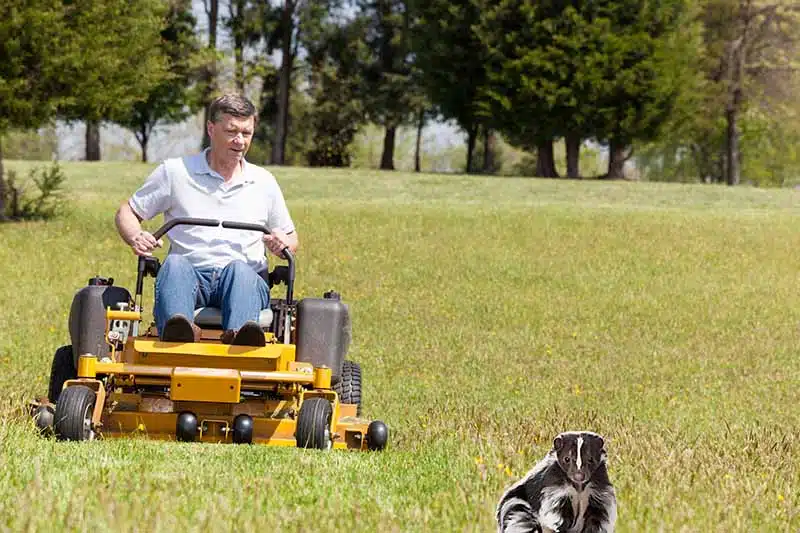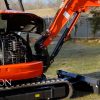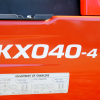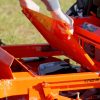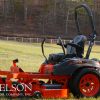Kubota is a world-class brand that speaks to the quality tools that residential, hobby farms, commercial ag, and construction companies rely on. Kubota products range from huge industrial equipment to smaller and easy-to-manage residential zero turn mowers. You find the same precision and quality in every Kubota product and that is one reason why Kubota is such a respected brand. This blog focuses on seven common problems with Kubota Zero Turn Mowers and their solutions.
One of the most amazing aspects offered by Kubota Zero Turn Mowers is that you get professional lawn results without the professional. The entire point of a zero turn mower – regardless of the brand – is the efficient and high-quality results these machines offer. Still, what happens when the results are not what you expect? Keep reading as we go through seven common problems with Kubota Zero Turn Mowers and some of the solutions you can use to correct them.
Feathering – The grass is not cut evenly
Some people refer to this problem as streaking – as though a brush stroke is visible on a freshly painted wall – in this case, you can see the path that the mower took due to the uneven cut of the grass.
Causes and Solutions

Mowing occurs when sharp steel meets vegetation material at the right speed. A few things can cause the grass to look feathered. Dull blades will not cut grass cleanly nor will blades that are damaged. If you’ve run over debris, such as rocks, the blades on your Kubota Zero Turn Mower may be dull or damaged.
Other problems have to do with the maintenance of the mower or lawn issues as you mow. If the grass is wet, it can cling to the mower deck and cause an obstruction so that the blade is not making contact with uncut grass. You can correct this by checking for clogs or grass clipping buildup under the mower. A service call to have the blade checked for damage or to have it sharpened at the start of the mowing season is an excellent way to correct any lawn-cutting defect due to blade condition.
If the blade is not dull or damaged and the grass is not compacted in the mower, then consider the engine or blade speed. It may simply be that the feathering is caused by a blade speed that is too slow.
Uneven Cutting
Uneven cutting means that the blade is not spinning on a horizontal line. That can be caused by several problems including an incorrectly installed blade. The first thing you want to check if you notice uneven cutting is the tire pressure of the mower. A single tire with low pressure can cause the deck of the mower to tilt enough to cause uneven cutting. Another common problem with zero turn mowers is that the mowing deck is not adjusted to a uniform height.
Physical damage to the mower can also cause uneven cutting.
Check for:
- Check the blade for damage and sharpness.
- Check that the mowing deck is not occluded with grass clippings.
- Check also that there is no damage to the moving parts of the mower including the spindle.
if you find damage you can schedule a service call for the mower or if it is simply a dull blade, you can bring the blade in for sharpening if you are not set up to sharpen it yourself.
Divots or Scalping
A divot occurs when the mowing blade strikes the ground and removes either part of the lawn or creates a dirt spot. The mower has effectively removed the grass rather than cutting it. This problem occurs either because the deck is not adjusted correctly or because the terrain has changed. A hole in which a wheel dips can cause the mowing blade to strike the earth rather than continue its horizontal motion. There is also a possibility that a mole or vole has created a tunnel and pushed up the dirt. Tree roots can also cause an uplifting of the ground.
Easy Fixes
Be sure to check the ground before you begin to mow. Investigate the lawn area if the grass is taller than usual, especially if there has been a wind event or seasonal changes when branches may fall. Holes appear in lawns for a variety of reasons, such as sprinkler damage, wildlife, and tree roots. Double-check the mower settings and adjust the deck before you begin. It is a good idea to clean the mower deck after each use so that compacted grass caught in the deck or blade areas does not remain there. You can also check the trueness of the blade to make sure there is no damage to the blade or mower.
Zero Turn Maintenance – What You Need to Know
Some of the common problems that users experience with Kubota Zero Turn Mowers come down to poor maintenance. It is not unheard of that you may encounter a defective part that is why Kubota offers a solid warranty. Just like with your truck you have to do maintenance on tools. That means you need to:
- Sharpen the mowing blade at least annually if not before you tackle a big mowing job.
- Clean the mowing deck making sure that there is not a build-up of grass clippings that adhere there. Leaving grass clippings in the mower deck is a good way to start corrosion.
- Checking that wire or string does not become bound around the spindle.
- Check the Blade for defects in the cutting edge or that it is loose.
- Annually, you should check the mowing deck adjustments to make sure that they are in good working order. You should check the mowing deck setting to make sure it is balanced each time you use the mower.
Additionally, protect your investment in your Kubota Zero Turn Mower by keeping the engine and transmission in top condition. You can get two decades of use out of a Kubota Zero Turn Mower if you are diligent. These are precision machines made from top-quality parts and with attention to detail. You can prevent a lot of problems by simply doing regular maintenance such as:
- Checking and changing the oil as recommended or anytime you’ve abused the machine with a tough mowing job.
- Check the air filter – cleaning or replacing the air filter at least annually and often before you use it. A dirty air filter robs the engine of power and that can affect the quality of the mow.
- Check the transmission fluid levels and service the transmissions as recommended.
- Checking the tire pressure and tread – low tire pressure can cause the mower deck to dip or become unbalanced resulting in divots or scalping of the lawn while mowing.
Kubota Zero Turn Troubleshooting combined with regular maintenance can help to avoid these common zero turn mower problems.
7 Common Problems with Kubota Zero Turn Mowers
- Zero Turn Mower Deck Problem – Poor balance and uneven grass cutting
- Zero Turn Mower Hydraulic Transmission Problem – low transmission fluid can affect torque which will cause the mower to be sluggish or the blade to struggle to turn at full speed.
- Zero Turn Mower Starting Problems – Corroded batteries, clogged fuel filters, dirty fuel, spark plug corrosion, etc., can all be reasons why your Kubota Zero Turn Mower won’t start. Many of these issues are preventable with regular maintenance or service from your local Nelson Tractor team.
- Zero Turn Mower Fuel Problem – Cleaning or replacing the fuel filter is key. Also making sure that you are using quality fuel and not contaminated fuel for your tractor will go a long way in keeping the machine running at peak performance and with the best fuel economy.
- Poor mowing Quality – A dull or damaged cutting blade is often the problem. Be sure to check the blade before each use for damage and sharpness. Check also that the grass is not overly wet before you start. Wet grass can stick inside the mowing deck and cause the blade to struggle to spin at full speed.
- Kubota Zero Turn Steering Problems – Check the tire air pressure before mowing. A low tire or a tire that is not spinning or turning correctly can not only cause problems with the quality of the mow but also be a safety issue. Inspect the levers and linkage to make sure that they are not broken or obstructed. Sometimes the linkage may need to be adjusted, or the bushings cleaned or replaced. Zero Turn Mowers can be a challenge to drive when you first start out with them.
- Loss of Power or Cutting Torque – Check the transmission fluid level to see if the fluid level is low. Check the air filter to see if it is dirty. If the engine is sputtering, you can also check the fuel filter to make sure it is clean or if there may be condensation in the gas. Generally, a loss in power means that the engine or transmission is struggling. Either can be caused by a single issue or a combination of issues. Condensation in the fuel and a dirty air filter. In terms of power at the cutting blade, check for binding – string, wire, weeds – or a lot of grass inside the mowing deck.
Many of the Kubota zero turn mower problems come down to maintenance or parts that are not reinstalled correctly. For example, a cutting blade installed upside down or a clogged fuel filter will cause the mower to not perform as designed. Many common problems with zero turn mowers are easy to fix if you know what to look for and have the tools and know-how to do simple maintenance – replace the air filter or fuel filter. It is important to know what you are doing though before tackling maintenance at home.
End of season and winter maintenance are also critical to the longevity of your Kubota Zero Turn Mower. You can also bring your Zero turn mower to Nelson Tractor Company for service or stop by to pick up Kubota Zero Turn parts. We offer full service and a huge parts warehouse. If you’ve added a Kubota Zero Turn Mower to your home expect a solid tool with quality design and fewer breakdowns that are not maintenance related.


